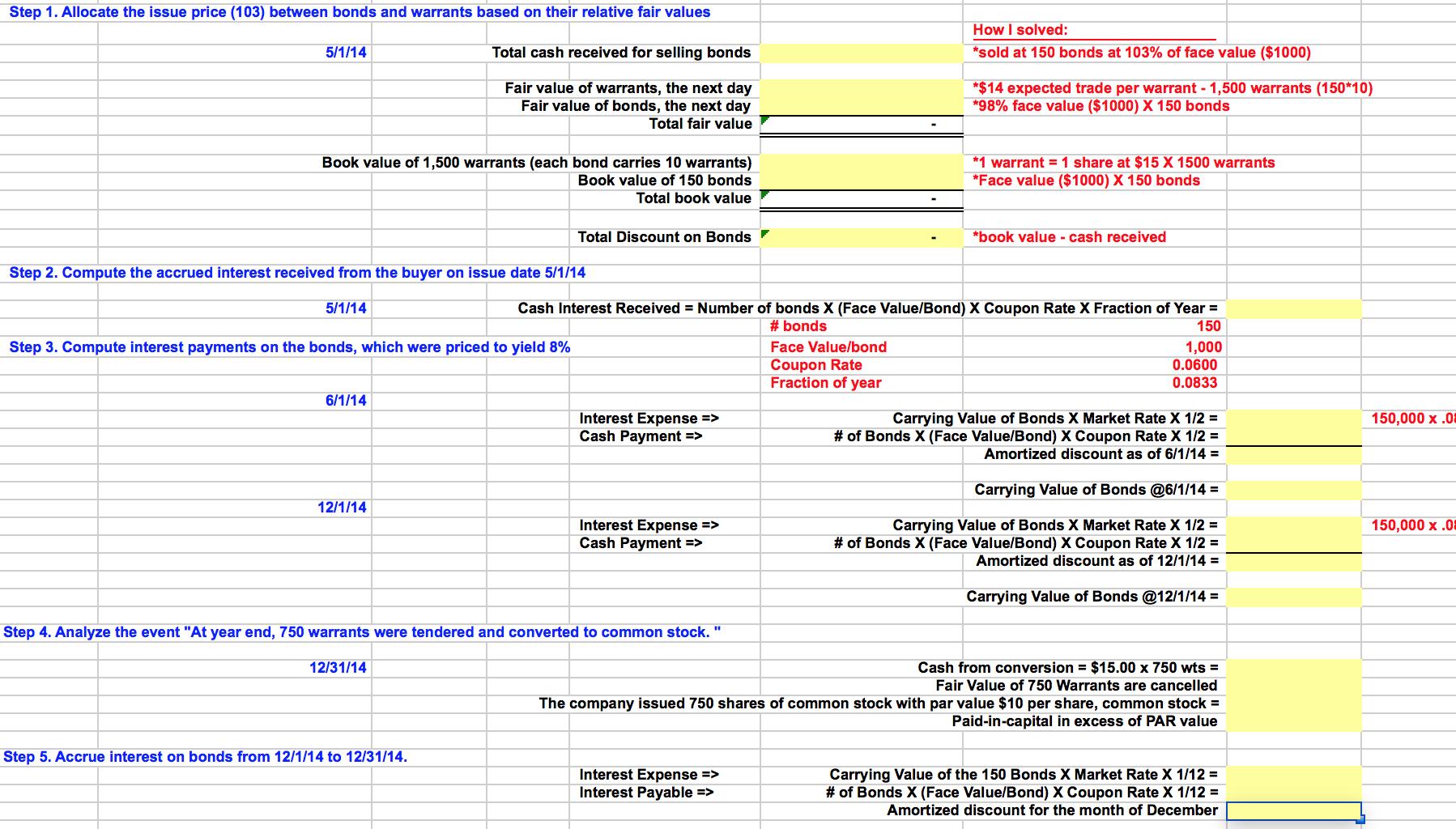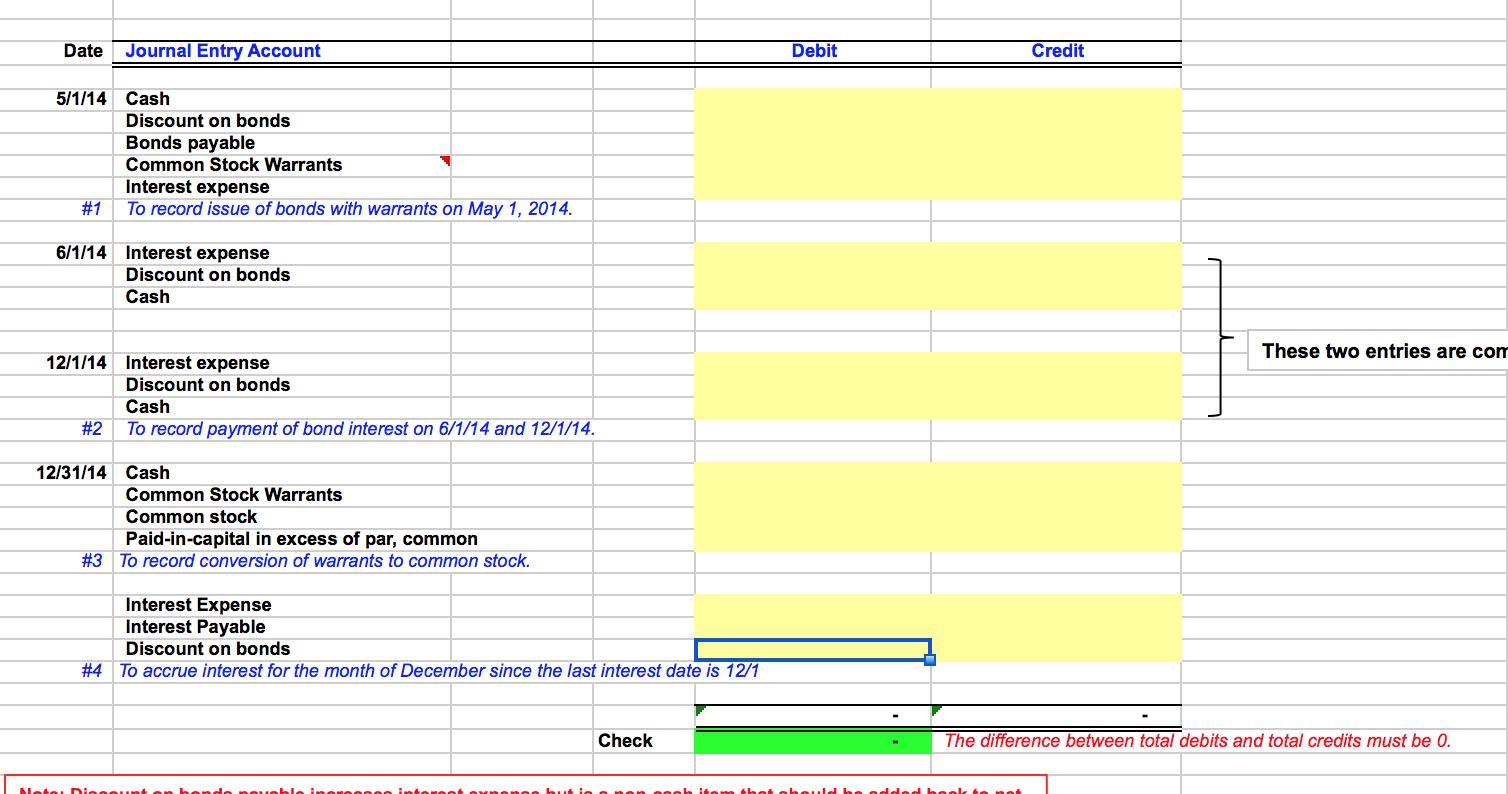Question
On May 1, 2014, the company sold an additional 150 bonds with warrants attached. The bonds, which mature in 2029, had a face value of
On May 1, 2014, the company sold an additional 150 bonds with warrants attached. The bonds, which mature in 2029, had a face value of $1,000 each, with 6% annual coupon rate, interest due June 1 and December 1. (Each bond carries 10 warrants to buy one share of the common stock of the company at $15.00 per share one warrant .) The bonds were sold to a private investor at 103 (priced to yield 8%), plus accrued interest. By comparison to other similar securities, the company has determined that the day after the sale the fair value of the bonds without the warrants was 98, and that the warrants would be expected to trade at 14. On December 31, 2014, 750 warrants (with the appropriate amount of cash) were tendered to the company in exchange for common stock. The average price of the common stock during 2014 was $40 per share.
XYZ, Inc. began 2014 with 100,000 shares of $10 par common stock that were initially issued for $17.50 per share. These shares have been recorded.
Assumption: Effective interest method is used for discount amortization.
Step 1. Allocate the issue price (103) between bonds and warrants based on their relative fair values
Step 2. Compute the accrued interest received from the buyer on issue date 5/1/14
Step 3. Compute interest payments on the bonds, which were priced to yield 8%
Step 4. Analyze the event "At year end, 750 warrants were tendered and converted to common stock.
Step 5. Accrue interest on bonds from 12/1/14 to 12/31/14.


Step 1. Allocate the issue price (103) between bonds and warrants based on their relative fair values Total cash received for selling bonds Fair value of warrants, the next day Fair value of bonds, the next day Total fair value 5/1/14 Book value of 1,500 warrants (each bond carries 10 warrants) Book value of 150 bonds Total book value Step 2. Compute the accrued interest received from the buyer on issue date 5/1/14 5/1/14 Step 3. Compute interest payments on the bonds, which were priced to yield 8% 6/1/14 12/1/14 Total Discount on Bonds Step 5. Accrue interest on bonds from 12/1/14 to 12/31/14. Interest Expense => Cash Payment => Interest Expense => Cash Payment => Step 4. Analyze the event "At year end, 750 warrants were tendered and converted to common stock. " 12/31/14 Cash Interest Received = Number of bonds X (Face Value/Bond) X Coupon Rate X Fraction of Year = # bonds 150 How I solved: *sold at 150 bonds at 103% of face value ($1000) Face Value/bond Coupon Rate Fraction of year Interest Expense => Interest Payable => *$14 expected trade per warrant - 1,500 warrants (150*10) *98% face value ($1000) X 150 bonds *1 warrant = 1 share at $15 X 1500 warrants *Face value ($1000) X 150 bonds *book value - cash received 1,000 0.0600 0.0833 Carrying Value of Bonds X Market Rate X 1/2 = # of Bonds X (Face Value/Bond) X Coupon Rate X 1/2 = Amortized discount as of 6/1/14 = Carrying Value of Bonds @6/1/14 = Carrying Value of Bonds X Market Rate X 1/2 = # of Bonds X (Face Value/Bond) X Coupon Rate X 1/2 = Amortized discount as of 12/1/14 = Carrying Value of Bonds @12/1/14 = Cash from conversion = $15.00 x 750 wts = Fair Value of 750 Warrants are cancelled The company issued 750 shares of common stock with par value $10 per share, common stock = Paid-in-capital in excess of PAR value Carrying Value of the 150 Bonds X Market Rate X 1/12 = # of Bonds X (Face Value/Bond) X Coupon Rate X 1/12 = Amortized discount for the month of December 150,000 x .08 150,000 x .08
Step by Step Solution
3.52 Rating (162 Votes )
There are 3 Steps involved in it
Step: 1
Answer and Explanation Step 1 Allocate the issue price 103 between bonds and warrants based on their ...
Get Instant Access to Expert-Tailored Solutions
See step-by-step solutions with expert insights and AI powered tools for academic success
Step: 2

Step: 3

Ace Your Homework with AI
Get the answers you need in no time with our AI-driven, step-by-step assistance
Get Started


